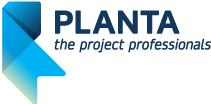Project Management Glossary
Key terms from project, portfolio, and task management

A
Agile
Agile refers to a method in which teams work in short, time-limited sprints. This allows them to respond to changes in a flexible way.
B
Backlog
A backlog is a list with the tasks of a project or work package which are yet to be completed.
Bottleneck
A bottleneck describes a delay in a work phase which may occur due to different, partially unpredictable problems (illness of employees, defective machine, etc.) and which may reduce the planned work flow or the capacity in the project.
Budget
The budget is the given financial framework of a project. The planned revenues and expenses are compared here.
C
Cascade model
The cascade model is a project management method in which the individual work packages are processed one-by-one. Each project phase generally builds up on the results of the previous phase. Therefore, changes in the course of a project are hard to realize.
Controlling
Controlling is the check, monitoring, and control of a project across the entire runtime. Project key figures serve to measure project progress and success of a project in terms of costs, effort, and dates.
Customizing
Customizing means adapting individual standard elements in a software system to user-specific requirements. This can range from adjustments to the interface through to changes to the software code.
D
Dashboard
Dashboards are user interfaces which visualize data from reports in graphics. Dashboards contained in project management summarize figures to allow project planning and controlling, providing the management with a better overview. Dashboards are also called cockpits.
G
Gantt chart
A Gantt chart is a bar chart which shows the temporal dependencies between project tasks.
H
Hybrid
Hybrid project management combines different project management methods to create an individual approach. Scrum-cascade is an example of such a hybrid method. Here, agile methods are used for a swift implementation of smaller scale projects and the cascade method is used for more complex projects.
I
Idea
In project management, ideas are project proposals which are initially put down without details such as dates and resource assignment. Ideas can be developed into proposals or projects.
IT tickets
An IT ticket is an electronically recorded problem, request, or event for which support is solicited from the IT department.
J
Jour fixe
The Jour fixe is a regular and recurring date for the same persons of a project team, including stakeholders if necessary.
K
Kanban
Kanban is a method in agile project management which visually represents tasks and procedures. Most of the time, Kanban boards, i.e. project boards in which the task cards are aligned in columns and swim lanes, are used here.
Key Performance Indicator (KPI)
KPIs are key figures which serve to measure the performance of activities, project progress, and degree to which the objective has been achieved.
Conflict management
Conflict management is responsible for resolving emerging problems. These include, e.g., different objectives within a project or difficulties in resource distribution.
Cost management
Cost management includes all activities for planning, analysis, and control of project costs with the objective to minimize the risk of a budget overrun.
Cost planning
Cost planning is the estimate of future costs and the effort for individual projects and tasks.
M
Master milestone
A master milestone is a milestone with particularly high significance.
Milestone
A milestone is an intermediate objective in a project and marks the completion of an important work step. A milestones allows you to monitor the progress and the timeliness of the project.
Multi-project management
Multi-project management is an “organizational and process framework for managing multiple individual projects” (DIN 69909). In multi-project management, all individual projects of the company can be managed together to stay on top of dates, resources, costs as well as risks and opportunities. The company projects can be organized in portfolios or programs.
O
Outline planning
Ouline planning is the first step in project planning. In this step, project phases (cf. process model), milestones und das Budget, and the budget, project objectives and project result are defined.
(cf. process model), milestones, and the budget, project objectives and project result are defined.
P
Process planning
Process planning means the documentation of a planned operational process which includes all work packages and their dependencies. In the schedule, the work packages of the process planning are structured in terms of time and assigned to the resources which execute them.
Programs
In project-management, a program combines several projects. Bundling projects to programs makes sense for projects which share the same objectives and helps to keep an overview of milestones and costs of projects that belong together.
Project
A project is a planned or already started, timely limited and usually complex task with coordinated individual tasks and a defined objective.
Project communication
Project communication means the exchange of information between all persons involved in a project. This concerns management, project management, and project teams, but also external persons and stakeholders.
Project life cycle
The project life cycle is the timespan from the planning of a project to its completion. It is usually divided into four phases: initiation, planning, execution, and completion.
Project plan
A project plan summarizes the most important points of a project which are necessary to achieve a particular objective. Phases, tasks, persons responsible, due dates. Further details are recorded in the project structure plan, cost plan, or resource plan.
Project Portfolio Management (PPM)
In PPM, the projects are planned strategically with regard to the company objectives. This includes the entire strategic portfolio decision making process from the project idea via the evaluation of risks and opportunities up to the project request and the planned project.
Process model
A process model shows the phases of the project management process, e.g. complying with DIN 69901: initialization, definition, planning, controlling, and completion. These phases again include several subordinate processes. Process models allow for the mapping of individual workflows in a software.
Project objective
The project objective is the result or the status which is to be achieved at the end of a project. The project objective should be clearly defined and measurable in order for the success of a project to be measurable.
Project team
The project team consists of all persons who work together on a project. The persons involved in a project can be from different departments.
Proposal
A proposal is the preliminary stage of a project. It is more concrete than a project idea, but not yet as elaborate as an actual project. In contrast to a project, work packages, budgets, and resources must not yet be planned in detail.
Q
Quality Management
In quality management, measures for quality assurance in the project are taken. This includes, a.o., the planning and controlling of processes, which serves to achieve a high quality in the project.
R
Resources
Resources are means which are required to carry out projects. They can be persons, departments, machines, and facilities but also time and financial resources.
Resource management
Resource management is a process of planning, scheduling, and allocating resources involved in a project.
Risk management
Risk management assists you in project decisions. The objective is to identify potential risks, to evaluate them and to take appropriate measures. Risk management is thus responsible for increasing the chances of achieving project objectives.
Risk value
The risk value quantifies the expected damage. It is determined from the estimated extent of damage and the probability of occurrence of the damage.
Road map
A road map provides an overview of the project progress and only shows the most important steps, milestones, and objectives.
S
Scrum
Scrum is an agile method in project management in which a team works incrementally in short iterations (called sprints) to make continuous progress toward common objectives.
Single Sign-On
Single sign-on is an IT authentication method in which a user has access to all computers and services for which he is authorized from his workstation with a single login procedure.
Sprint
Sprints are short, defined periods in which project teams complete their tasks.
Stakeholder
Stakeholders are persons who are interested in or affected by a project. They do not only include the project teams but also clients and, possibly, external providers.
Status report
A status report captures the current status of a project and its progress at the respective point in time. This document serves to keep project managers and persons involved au courant.
T
Time recording
Time recording is the process in which employees record their hours worked. This does not only fulfill the legal obligation which exists in Germany since 2022, but also enables companies to track the progress of their projects and optimize resource use. Here you can learn how you can use time recording for project management.
Trend analysis
Ttrend analysis examines the current trend for the course of a project, such as cost, effort, risk, and opportunity trends. By means of timely forecasts of developments, their negative impact can be identified to take appropriate measures.
W
Webinar
A webinar (or web seminar) is a course or seminar which is broadcast live over the Internet.
WIP (Work in Progress)
Work in Progress means tasks which are being processed but have not yet been completed. In a Kanban Kanban board, WIP limits can be used to define how many cards a list can contain.
Work breakdown structure (WBS)
The work breakdown structure is the hierarchic structuring of a project in smaller work packages and is usually visualized in the form of a tree chart.


